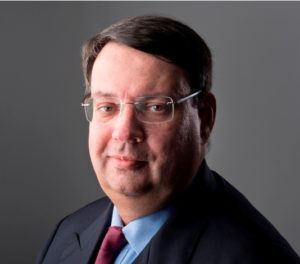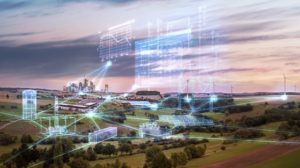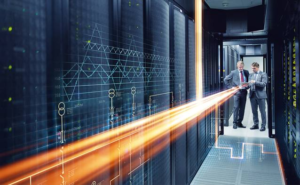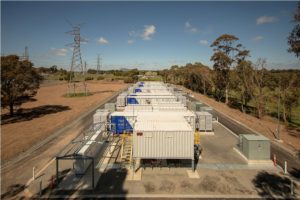 In this exclusive interview, Robert Demann, Head – Smart Infrastructure, Siemens Ltd, shares keen insights on “Smart Infrastructure”—a term that if often used but never fully appreciated. Demann explains that smart infrastructure is not limited to just power grids or e-mobility solutions. It is indeed an intelligent ecosystem that that intuitively responds to the needs of people and helps better utilization of resources. Demann also notes that India—a country that is witnessing increased economic activity—has great potential for smart infrastructure solutions.
In this exclusive interview, Robert Demann, Head – Smart Infrastructure, Siemens Ltd, shares keen insights on “Smart Infrastructure”—a term that if often used but never fully appreciated. Demann explains that smart infrastructure is not limited to just power grids or e-mobility solutions. It is indeed an intelligent ecosystem that that intuitively responds to the needs of people and helps better utilization of resources. Demann also notes that India—a country that is witnessing increased economic activity—has great potential for smart infrastructure solutions.
The term “smart infrastructure” is often used these days. Is it possible to explain the term in brief and what its key objectives are? Is energy management the ultimate goal?
Unlike regular infrastructure, smart infrastructure is not about time and material needed to build it: it’s about the data needed to plan, manage and run the infrastructure it efficiently. Amidst globalization and increasing urbanization, this new way of thinking about infrastructure and the connected ecosystem of energy, buildings and industry is necessary.
With Smart Infrastructure from Siemens, we intelligently connect energy systems, buildings and industries to adapt and evolve the way we live and work. We work together with customers and partners to create an ecosystem that intuitively responds to the needs of people and helps customers to better use resources. It helps our customers to thrive and communities to progress and support sustainable development.
We do this from the macro to the micro level—from physical products, components and systems to connected, cloud-based digital offerings and services. Siemens offers a broad portfolio of grid control and automation; low- and medium-voltage power distribution, switching and control; and building automation, fire safety and security, HVAC control and energy solutions.
In this context, energy management is only one of the relevant aspects for focus.
End customers can benefit from cost reductions, increase in lifespan of assets and greater reliability of their network.
In the context of India, what are the major drawbacks of the existing power distribution grid, and how will “smart grids” remedy the situation?
 Let me share an experience – a few months back, while taking an elevator ride in an upscale hotel in a Tier-1 city, I got stuck for 5-7 minutes, when there was an outage.
Let me share an experience – a few months back, while taking an elevator ride in an upscale hotel in a Tier-1 city, I got stuck for 5-7 minutes, when there was an outage.
This highlights the main challenges facing the power grid today — lack of reliable 24×7 power supply, poor quality of power and limited resources available to the utilities in modernization and building new power infrastructure.
This contrasts with a “smart city” like Hong Kong that ensures less than 5 minutes of power outages in the whole year. These are the levels of grid efficiency that we need to aspire.
As energy demand increases due to more electricity consumers, it becomes vital to boost asset transparency, enhance customer service and incorporate decentralized resources with minimal impact. Flawless operation of the entire grid in our increasingly distributed energy landscape is the basic prerequisite for any network operator, electricity supplier, and industrial enterprise today.
Smart grid solutions help to achieve all the above by monitoring, measuring and control of power flows in real time that can contribute to identification of losses and thereby appropriate technical and managerial actions can be taken to arrest the losses. These include usage of condition monitoring equipment to track the health of equipment in substations, maintenance planning, and usage of dynamic software and analytics for decision-making support.
End customers can benefit from cost reductions, increase in lifespan of assets and greater reliability of their network.
Please cite a few smart grid projects that Siemens is associated with in India. We appreciate that Siemens has been one of the early players in Indian smart grid projects.
India has accounted for nearly 10 per cent of the world’s increase in economic activity since 2005. A resilient and reliable power supply offers better opportunities for schools, businesses and entrepreneurs – essential for continued sustainable economic growth.
The size of the northern region transmission grid, overseen by Northern Regional Load Dispatch Centre (NRLDC), has nearly doubled over the last decade, covering almost 30 per cent of the population. Managing grid operations is a huge task made even more complex as the share of renewable energy sources grows. Working with NRLDC, Siemens installed a hardware and software solution built around the Spectrum Power 7 Control Center Platform. This new system features eight State Load Dispatch Centres, one Regional Load Dispatch Centre, and three backup control centers. The seamless and speedy takeover of this new platform was implemented without any interruption to grid operations. NRLDC is able now to manage its complex operations more effectively and in real time. The fast and accurate system minimizes power losses and load shedding, reduces downtime and aids the efficient handling of any disruptions.
Another successful example is the implementation of our digitalization offerings at utilities in India. We have integrated an ‘Augmented Reality’ app to access relay data and developed fault analyzer for the customer. This has improved response time for fault rectification, enabled simulation and test of fault scenarios and provided predictive maintenance increasing service quality for the customer.
Yet another digitalization project, though not related to the electric but the traffic grid, involves setting up a dynamic “AI Traffic Control” for one of the busiest signal junctions in a major Indian city. Siemens’ solution enabled real time dynamic control-AI with predictive and self-learning capability that helps optimize traffic management of entire route. This is an IoT-based modular system that can easily be scaled up to include multiple other signal junctions.
As Siemens Smart Infrastructure, we are building on our core strengths and continuing to deliver solid plans for buildings, energy systems and industries.
We understand that “medium voltage power distribution” is a key component of smart infrastructure in the context of a commercial building or factory. Tell us what the various aspects are that “MV power distribution” would address.
Traditionally, MV power distribution networks carry power to the last few miles from transmission or sub-transmission to the user. Distribution networks are distinguished from transmission networks by their voltage level (typically, levels up to 33kV) and topology.
 Today’s environment is witnessing a plethora of changes in the distribution network. These changes are a result of increasing urbanization, growth in taller buildings, decentralization and resulting integration of renewable energy and industrialization requirements. Consumer profiles and requirements are also changing dramatically; new set of consumers such as data centres are emerging with increased reliability needs. On the other hand, the growth of consumers such as smart buildings is becoming increasingly more networked. They don’t just consume energy, but also store and distribute it. The grid doesn’t just end at the industrial plant or residential building but is becoming a part of it.
Today’s environment is witnessing a plethora of changes in the distribution network. These changes are a result of increasing urbanization, growth in taller buildings, decentralization and resulting integration of renewable energy and industrialization requirements. Consumer profiles and requirements are also changing dramatically; new set of consumers such as data centres are emerging with increased reliability needs. On the other hand, the growth of consumers such as smart buildings is becoming increasingly more networked. They don’t just consume energy, but also store and distribute it. The grid doesn’t just end at the industrial plant or residential building but is becoming a part of it.
Medium voltage power distribution networks are hence gearing up to accommodate these complexities with the help of increased intelligence in the network through automation and digital portfolio offerings. The demand for increased reliability requires “self-healing network solution”, with portfolio such as substation automation upgraded by implementing new distribution grid automation functions. These solutions ensure automatic fault localization, isolation and restoration, ensuring low outage times. In addition to a high level of personal safety, the reliability of the MV distribution system is particularly important for ensuring complete peace of mind, highest availability, completely digitalized, providing real time uptime efficiency & yet remaining economical.
Overall, how has been the response to Siemens’ smart infrastructure solutions in India so far?
As Siemens Smart Infrastructure, we are building on our core strengths and continuing to deliver solid plans for buildings, energy systems and industries. In addition, we are increasingly leveraging respective strengths of our diverse businesses to offer more rounded offerings to our customers. This is supported by a strong outreach to key customer verticals and stronger collaboration with our channel partners.
We are also systematically expanding our portfolio presence in the strong growth areas at the grid edge (e.g. in EV charging, decentralized energy systems) while strengthening our portfolio for India.
With launch of Siemens Smart Infrastructure, we launched Infrastructure 4.0 aimed at addressing smart campuses with offerings ranging from micro grid management, digital substations to energy efficiency offerings and Smart Surveillance & Emergency Response offerings.
An interesting example is our pilot with a large campus in design, supply and commissioning of renewable sources, EV charging stations and storage (Li-Ion batteries). This unique and complex project covers a large geographical span and enables transmission of power in multiple directions based on load requirements. Other examples include deployment of integrated command and control centres to manage large manufacturing locations and other such pilots.
With increasing renewable energy penetration and dynamic loads, use of battery energy storage systems will play a crucial role in providing reliable power.
Is there any marked difference between the approach of government and private customers?
We have a long history of engagement with both government and private sector clients and have witnessed good traction of our solutions with both sets of customers. Of course, the inherent complexities in procurement process of government customers have an impact on scaling up solutions from proof-of-concept to large scale deployments.
Given that India is pushing forward in areas like renewable energy, smart grids, energy storage, e-mobility, etc, how do you see the prospects for Siemens’ Smart Infrastructure solutions in the years ahead?
 In the face of increasing pollution across Indian cities, electromobility will be the key in creating an integrated climate, energy and mobility strategy. With FAME-II policy, Government of India is actively implementing the National Electric Mobility Mission Plan (NEMMP). Focus on electrifying the public transportation (e.g. buses) is a great initiative. But with increasing adoption of electromobility, as previously highlighted, will cause new challenges for MV power distribution and distribution grid operators.
In the face of increasing pollution across Indian cities, electromobility will be the key in creating an integrated climate, energy and mobility strategy. With FAME-II policy, Government of India is actively implementing the National Electric Mobility Mission Plan (NEMMP). Focus on electrifying the public transportation (e.g. buses) is a great initiative. But with increasing adoption of electromobility, as previously highlighted, will cause new challenges for MV power distribution and distribution grid operators.
Smart Infrastructure provides end-to-end solutions for electromobility such as charging infrastructure concept development, implementation of electrification systems, monitoring and control software for charging infrastructure. Our holistic portfolio ensures modular and scalable solutions that can be easily deployed for use at various touch-points in the network. For example, our eMobility portfolio has the unique ability of being a plug and play charging infrastructure and act as pantograph charging technology.
With increasing renewable energy penetration and dynamic loads, use of battery energy storage systems will play a crucial role in providing reliable power. India’s largest battery energy storage system—10MW/10MWh at Tata Power Delhi Distribution Ltd—is deployed based on our FLUENCE technology. We have the largest installed base of battery storage globally. this operational experience enables us to provide new service offerings and create customer value.
Our holistic offerings help address infrastructure challenges and contribute to sustainable development, helping us achieve our aim of “creating environments that care”.


